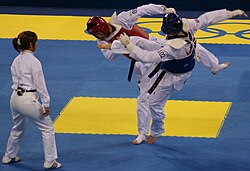| Revision as of 07:03, 18 June 2008 edit202.180.112.32 (talk) →Ranks, belts and promotion← Previous edit | Revision as of 07:03, 18 June 2008 edit undo202.180.112.32 (talk) →PhilosophyNext edit → | ||
| Line 14: | Line 14: | ||
| ==Philosophy== | |||
| Since taekwondo developed in several different ''kwan''s, there are several different expressions of taekwondo philosophy. Two are detailed in the articles for the ] and ]. | |||
| == Competition == | == Competition == | ||
Revision as of 07:03, 18 June 2008
as "the way of the fist and foot".
Taekwondo's popularity has resulted in the varied evolution of the martial art into several domains: as with many other arts, it combines combat techniques, self-defense, sport, exercise, meditation and philosophy.
There are two main systems of taekwondo as well as traditional tae-kwon-do, which is not competition oriented and focuses only on the self-defence and traditional value of the art. One comes from the Kukkiwon, the source of the sparring system "Shihap Kyorugi" which is an event at the summer Olympics and which is governed by the World Taekwondo Federation (WTF); the other comes from the International Taekwondo Federation (ITF), which was founded by General Choi Hong Hi, the father of taekwondo. Although there are doctrinal and technical differences among the two taekwondo styles and the various organizations, the art in general emphasizes kicks thrown from a mobile stance, employing the leg's greater reach and power (compared to the arm). Circular motions that generate power are of central importance. Also important to the generation of power is the movement of the hips while performing a punch or a block. Taekwondo training generally includes a system of blocks, punches, and open-handed strikes and may also include various take-downs or sweeps, throws, and joint locks.
NAH FISH
The word "Tae Kwon Do" is interpreted as meaning "the way of the fist and foot".
Competition
Taekwondo competition typically involves sparring, breaking, patterns, and self-defense (hosinsul). However, in Olympic taekwondo competition, only sparring is contested; and in Olympic sparring WTF competition rules are used.


WTF
Under WTF and Olympic rules, sparring is a full-contact event and takes place between two competitors in an area measuring 10 meters square. Each match or bout consists of three non-stop rounds of contact with rest between rounds. Junior fighters fight in 2-minute rounds with a 30-second break, while senior fighters fight in 3-minute rounds with 30-second breaks. Points are awarded for permitted, accurate, and powerful techniques to the legal scoring areas; light contact to a scoring area does not score any points. A kick or punch that makes contact with the opponent's hogu (a trunk protector that functions as a scoring target) scores one point; a kick to the head scores two points. Punches to the head are not allowed. If a competitor is knocked down by a scoring technique and the referee counts, then an additional point is awarded to the opponent.
At the end of three rounds, the competitor with the most points wins the match. If, during the match, one competitor gains a 7-point lead over the other, or if one competitor reaches a total of 12 points, then that competitor is immediately declared the winner and the match ends. In the event of a tie at the end of three rounds, a fourth "sudden death" overtime round will be held to determine the winner, after a 30-second rest period.
ITF
The ITF sparring rules are similar, but differ from the WTF rules in several respects. Hand attacks to the head are allowed; flying techniques score more points than grounded techniques; the competition area is slightly smaller (9 meters square instead of 10 meters); and competitors do not wear the hogu used in Olympic-style sparring (although they are required to wear approved foot and hand protection equipment). The ITF competition rules and regulations are available at the ITF information website.

ITF competitions also feature performances of patterns, breaking and "special techniques", a category where competitors preform prescribed board breaks at great heights.
AAU Competitions are very similar, except that different styles of pads and gear are allowed. Any gear that has the Olympic symbol and not the WTF logo on it is approved.
See also
External links
- "International Taekwon-do Federation Information Centre"
- Official site of the World Taekwondo Federation (WTF)
- International Taekwon-Do Federation
- International Taekwon-Do Federation
- International Taekwon-Do Federation
- Kukkiwon World Taekwondo Headquarters
- Taekwondo schools, tournaments and information.
- "Knowledge for Taekwondo Professionals"
- "All the terms used on Taekowndo are listed here"
- Collection of Taekwondo Videos
- www.Martialarts.Com.My Malaysia Martial Arts
- Taekwondo school in Chile
Community.
| Martial arts | |||||||||||||||||||||||||||||
|---|---|---|---|---|---|---|---|---|---|---|---|---|---|---|---|---|---|---|---|---|---|---|---|---|---|---|---|---|---|
| |||||||||||||||||||||||||||||
| |||||||||||||||||||||||||||||
- World Taekwondo Federation (2004). "Kyorugi rules". Rules. www.wtf.org. Retrieved 2007-08-11.
{{cite web}}: Cite has empty unknown parameter:|coauthors=(help) - International Taekwondo Federation (2000). "Competition Rules and Regulations". Rules. www.itf-information.com. Retrieved 2007-09-06.
{{cite web}}: Cite has empty unknown parameter:|coauthors=(help)